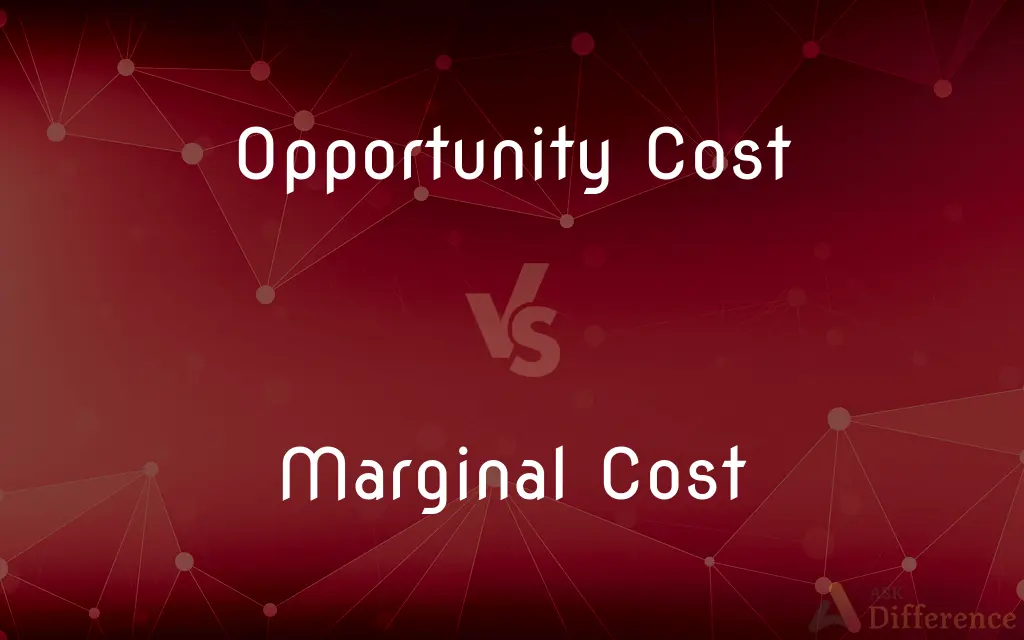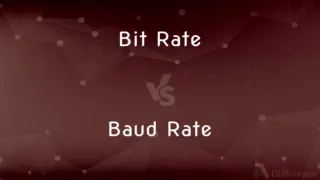Opportunity Cost vs. Marginal Cost — What's the Difference?
By Tayyaba Rehman — Published on January 15, 2024
Opportunity cost is the cost of the next best alternative forgone, while marginal cost refers to the cost incurred by producing one additional unit of a product.

Difference Between Opportunity Cost and Marginal Cost
Table of Contents
ADVERTISEMENT
Key Differences
Opportunity cost represents the benefit that is missed or given up when choosing one alternative over another. Marginal cost, on the other hand, is specifically concerned with the additional cost associated with producing one extra unit of output.
In decision-making, opportunity cost plays a key role in evaluating the relative worth of various choices. Marginal cost is crucial in production decisions, determining the cost-effectiveness of increasing production levels.
Opportunity cost is not just a monetary measure; it also includes time, effort, and resources. Marginal cost is typically calculated in monetary terms and is directly related to production expenses.
For businesses, opportunity cost can affect strategic planning and resource allocation. Marginal cost analysis helps in pricing strategies and optimizing production efficiency.
Opportunity cost is a broader concept, relevant in all sorts of decision-making scenarios. Marginal cost is a more specific economic term, mainly used in production and cost analysis.
ADVERTISEMENT
Comparison Chart
Definition
Cost of the next best alternative forgone
Cost of producing one additional unit
Application in Decision-Making
Evaluating choices and resource allocation
Production and cost efficiency decisions
Measurement
Includes monetary and non-monetary factors
Typically measured in monetary terms
Relevance
Broad, applicable in various scenarios
Specific to production and economics
Focus
Overall benefits forgone by a choice
Additional cost incurred in production
Compare with Definitions
Opportunity Cost
Cost of a foregone alternative.
Choosing to invest in stocks means the opportunity cost is the interest from a savings account.
Marginal Cost
Important in production decisions.
A factory evaluates marginal cost to decide on increasing production.
Opportunity Cost
Includes time and resources.
Spending time on a project has the opportunity cost of not pursuing other tasks.
Marginal Cost
Cost of producing an additional unit.
The marginal cost of manufacturing one more car includes the cost of materials and labor.
Opportunity Cost
A concept in decision-making.
The opportunity cost of a new marketing campaign is the alternative advertising strategies not pursued.
Marginal Cost
Calculated in monetary terms.
Determining the marginal cost helps in pricing the product appropriately.
Opportunity Cost
Evaluating different choices.
For a business, hiring more staff has an opportunity cost of reduced capital for other investments.
Marginal Cost
Helps in optimizing efficiency.
Analyzing marginal cost aids in maximizing profit margins.
Opportunity Cost
Measure of the benefits you give up.
Attending college has the opportunity cost of not working full time.
Marginal Cost
Directly related to production expenses.
Marginal cost analysis helps in understanding the impact of scaling up operations.
Common Curiosities
Why is marginal cost important in business?
It helps in determining the most efficient level of production.
What does marginal cost mean?
The cost incurred in producing one additional unit of a product.
How is opportunity cost used in personal finance?
To compare the benefits of different investment or spending choices.
Does opportunity cost affect everyday decisions?
Yes, it applies to all choices where alternatives are available.
How does opportunity cost impact investment decisions?
It helps investors assess the relative potential of different investments.
What is opportunity cost?
The cost of the next best alternative that is foregone.
What factors influence marginal cost in manufacturing?
Costs of materials, labor, and overhead expenses.
Can opportunity cost include non-monetary factors?
Yes, it includes time, effort, and other resources.
Is marginal cost always constant?
No, it can vary depending on the scale of production.
How do you calculate marginal cost?
By dividing the change in total production costs by the change in output level.
Is opportunity cost a tangible expense?
No, it's a theoretical cost representing missed benefits.
In what scenarios is marginal cost analysis crucial?
In making decisions about increasing or decreasing production levels.
How does opportunity cost relate to resource allocation?
It guides how to allocate resources for maximum benefit.
Can marginal cost decrease with increased production?
Yes, due to economies of scale in some cases.
Does opportunity cost have a direct financial impact?
Indirectly, as it represents the benefits that could have been gained from the next best alternative.
Share Your Discovery

Previous Comparison
Block Cipher vs. Stream Cipher
Next Comparison
Bit Rate vs. Baud RateAuthor Spotlight
Written by
Tayyaba RehmanTayyaba Rehman is a distinguished writer, currently serving as a primary contributor to askdifference.com. As a researcher in semantics and etymology, Tayyaba's passion for the complexity of languages and their distinctions has found a perfect home on the platform. Tayyaba delves into the intricacies of language, distinguishing between commonly confused words and phrases, thereby providing clarity for readers worldwide.
















































